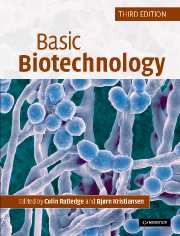Book contents
- Frontmatter
- Contents
- List of contributors
- Preface to the second edition
- Preface to the third edition
- Part I Fundamentals and principles
- Chapter 1 Public perception of biotechnology
- Chapter 2 Biochemistry and physiology of growth and metabolism
- Chapter 3 Stoichiometry and kinetics of microbial growth from a thermodynamic perspective
- Chapter 4 Genome management and analysis: prokaryotes
- Chapter 5 Genetic engineering: yeasts and filamentous fungi
- Chapter 6 Microbial process kinetics
- Chapter 7 Bioreactor design
- Chapter 8 Mass transfer
- Chapter 9 Downstream processing
- Chapter 10 Measurement, monitoring, modelling and control
- Chapter 11 Process economics
- Part II Practical applications
- Index
Chapter 6 - Microbial process kinetics
Published online by Cambridge University Press: 05 June 2012
- Frontmatter
- Contents
- List of contributors
- Preface to the second edition
- Preface to the third edition
- Part I Fundamentals and principles
- Chapter 1 Public perception of biotechnology
- Chapter 2 Biochemistry and physiology of growth and metabolism
- Chapter 3 Stoichiometry and kinetics of microbial growth from a thermodynamic perspective
- Chapter 4 Genome management and analysis: prokaryotes
- Chapter 5 Genetic engineering: yeasts and filamentous fungi
- Chapter 6 Microbial process kinetics
- Chapter 7 Bioreactor design
- Chapter 8 Mass transfer
- Chapter 9 Downstream processing
- Chapter 10 Measurement, monitoring, modelling and control
- Chapter 11 Process economics
- Part II Practical applications
- Index
Summary
Introduction
Quantitative description of cellular processes is an indispensable tool in the design of fermentation processes. Thus, the two most important quantitative design parameters, yield and productivity, are quantitative measures that specify how the cells convert the substrates to the product. The yield specifies the amount of product obtained from the substrate (or raw material) and the productivity specifies the rate of product formation. These two design parameters can easily be derived from experimental data, e.g. from measurement of the substrate consumption and the product formation. However, what is more difficult is to predict how they change with the operating conditions, e.g. if the medium composition changes or the temperature changes. In order to do this it is necessary to set up a mathematical model (see Box 6.1), which may be anything from a simple empirical correlation that specifies the product formation rate as a function of the medium composition, to a complex model that accounts for all the major cellular reactions involved in the conversion of the substrates to the product. Independent of the model structure, the process of defining a quantitative description of a fermentation process involves a number of steps (Fig. 6.1).
A key aspect in setting up a model is to specify the model's complexity. This depends much on the aim of the work, i.e. what the model is going to be used for, as discussed in Section 6.2.1.
- Type
- Chapter
- Information
- Basic Biotechnology , pp. 155 - 180Publisher: Cambridge University PressPrint publication year: 2006
- 5
- Cited by



